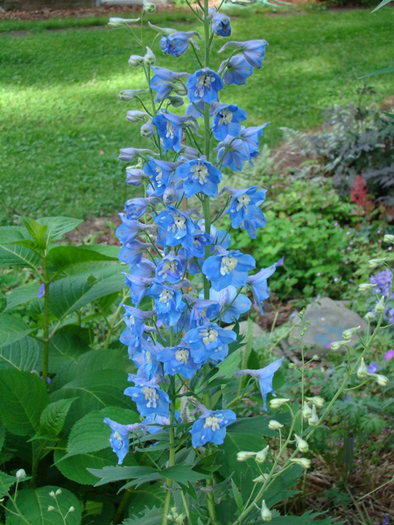

Roses, and less often peonies, are referred to as the queens of the garden. If this is the case, then surely delphiniums must be the kings.
And the most royal of these kings has always been
delphinium elatum,
commonly known as the English delphinium. These magnificent plants regularly grow to a height of 6 feet, but can often be found even taller. To see them in England is to see horticultural magnificence.
But here in America, we have struggled with this plant. There is a great deal of misinformation and lots of bad seed being sown that makes growing it difficult. In a sense, it’s a lesson in genetic disintegration. Or at least genetic degradation due to careless breeding.
In the States, the main strain of delphiniums, the “Round Table” strain, comes from a line known as the “Pacific Giants.” These include: the Black Knight, Guinevere, Astolat and Galahad, names you might recognize from Arthurian legend. But after years of haphazard breeding, the colors, the vigor, the hardiness and disease resistance of this strain has deteriorated and it’s become a real crapshoot when buying these plants as you really don’t know what you’re getting.
In a newsletter from a public garden 20 years ago, they were referred to as “tender and unreliable.” A garden center in East Hampton wouldn’t carry them because “they don’t do well.” And today, a local landscape contractor and designer won’t use them because he says they “never overwinter” and on a large Water Mill estate, I know a woman who plants new ones every, year throwing out the old ones even if they are still alive.
The problem stems from the fact that virtually all of our delphiniums are grown from seed. This guarantees that some of the good traits, and all of the bad traits, are passed from plant to plant.
In England though, the best delphiniums are grown vegetatively from cuttings. So only the best traits are passed from one year to the next and one plant to the next.
Many years ago, the White Flower Farm in Connecticut began an effort to develop an American line of vegetatively produced delphs. But the process proved to be long, expensive and complicated and was abandoned.
So, we return to the dream, to develop a line of magnificent garden delphiniums that can be grown from seed and will produce true colors, hardiness and disease resistance from one generation to the next.
A plant such as Black Knight should have flower petals of the deepest purple with a black “bee.” A plant like Galahad should have pure white flower petals with a black “bee.” Instead, we now get mixes, nears and almosts. And this is to say nothing of unreliable hardiness and continuing disease problems.
These plants are easy enough to grow, though. They love our mild maritime climate on the South Fork. And with a good organic soil, plenty of nutrients and staking where the wind can be an issue, these taller delphiniums can be simply stunning, even if chancy.
But there is hope. For years the Delphinium Society of the Royal Horticultural Society has been testing and breeding these plants and conducting extensive trials. Members of the society can get annual seed distributions. And last year, I found a man in upstate New York who sells these seed-grown plants for just two days every year. Of course, he sells out every year. His year-old plants cost $10 in small pots.
Last year, I was fortunate enough to get 20 plants from this guy. But no blues—he sold out of blues on Saturday and I didn’t get there until Sunday. He told me they were absolutely hardy, very disease-resistant and he offered about a dozen color choices. I’m happy to say that every single plant made it through the winter and in a few weeks I hope to have more to report.
I’d love to tell you this man’s name and how to get to his sale this weekend. But I’m afraid that after telling you, I’d have to kill you. The good news is that you can get the same seed by simply joining the Royal Horticultural Delphinium Society and grow your own.
Ah, but there’s more news and it’s even better. For a number of years, I’ve been hearing rumors about a new strain of
delphinium elatum
that was being worked on in New Zealand. Word was that this strain rivaled and bettered the Pacific Giant Round Table strains with more reliable color, better disease-resistance and excellent cold hardiness. I kept my antenna tuned, but still only heard the rumors.
But about a year ago I read an article by British garden writer Graham Rice in which he spoke about the “New Millennium Delphiniums” being developed in New Zealand by Terry Dowdeswell. Through careful and painstaking hand-pollination, Mr. Dowdeswell has produced “a fantastic range of colors ensuring that variations in colors and quality are eliminated so you can really depend on the results,” according to Mr. Rice. And last year, one of his “Sweethearts” varieties won the Royal Horticultural Society “Award of Garden Merit.”
So far I’ve found only a few of his introductions in the States, the closest being from a nursery in Maine (plantviewfarm.com). But you can buy seed directly from Dowdeswell’s Delphiniums Ltd. at delphinium.co.nz. The site is just brimming with information on delphinium culture, the background on his plants and breeding program, how to order seed, and lots and lots of pictures that will make you want to grow every variety he offers.
This site has me soooo tempted to get back into the nursery business. Keep growing.
They don’t mind the cold, but really resent the heat, so keep them out of spots that are hot and dry.
Delphiniums tend to be heavy feeders, so for the best results, use time-release fertilizer or frequent applications of a balanced organic fertilizer.
Slugs will go after the young foliage as soon as it emerges in the spring, so bait the plants early to protect them.
In many cases, if the flowers are removed when faded in early summer, you may get a second blooming season early in the fall. I’ve always suspected though that those plants that are allowed to bloom twice are those most susceptible to not overwintering. My theory is that these plants put so much energy into their second blooming period that root development and carbohydrate storage that allows for good overwintering is sacrificed.
Some purists insist that their plants don’t need staking. I don’t like taking the risk of damaged flower stalks with our East End winds so I stake, but very surreptitiously, with the right color stakes and ties.
Never tie the stem to the stake. Use a figure-eight tying method with half of the eight around the stake and half around the stem. This allows for some stem movement as well as growth.
 More Posts from Andrew Messinger
More Posts from Andrew Messinger